By Whitney Campbell and Jackie McFarland
After years of hoping, bidding, planning and building, the Kentucky Horse Park gates officially closed for the 2010 Alltech FEI World Equestrian Games in Lexington, yet the economical and reputable impact the city and state experienced during the 16 days of competition still lingers. Hosted in the United States for the first time, the city and state lived up to its reputation as the acclaimed ‘Horse Capital of the World’ when hosting this international equine event. The 16 days of grueling competition included eight different disciplines of equestrian sport, challenging 632 athletes and 752 horses from 58 countries for their chance of a WEG 2010 Medal. Competition aside, from the extensive Alltech experience, fabulously painted horses, shopping galore to the demonstrations throughout the facility, the amount of attractions available for visitors was abundant.

And for Openers…
The theme of the Opening Ceremonies was based around the athleticism, versatility, spirit, and the partnership between man and horse. Spectators enjoyed demonstrations and performances by racehorses, a Friesian Dressage Drill Team, Saddlebreds and many other equestrian entertainers. The traditional parade of athletes included all 58 competing countries. Midway through the ceremonies, FEI President HRH Princess Haya declared the official Opening of the 2010 Alltech FEI World Equestrian Games by commenting, “For the first time, the World Equestrian Games have crossed an ocean to bring the best of our sport to another continent. We are witnessing a new beginning that will help spread the magic of horse sport and inspire young equestrian athletes to aim for the top.”
Reining in its Second WEG
Before the evening’s Opening Ceremonies, Reining, the only competing discipline that originated in the United States, was underway. Since Reining was added as a discipline at the 2006 World Equestrian Games, it has opened the doors for a broader and more diverse horse culture to participate at the Games. Judged on the athletic ability of a western type horse in a show arena, the format of competition at the games involves two days of Team Competition, a Qualifying Competition, and finally an Individual Final Competition. The team made up of Tim McQuay, Craig Schmersal, Tom McCutcheon and Shawn Flarida along with their talented quarter horses won the Team Gold. There was an unfortunate turn of events in the Individuals for Gold Medal favorite Shawn Flarida when his stirrup broke during one of his movements, resulting his hand touching the saddle and an immediate five point deduction from each judge. However his teammates Tom McCutcheon and Craig Schmersal were still able to clinch the Gold and Silver Medals in Individual Reining.
Enduring Sport
The second day of the Games held the longest continuous competition of all eight disciplines, Endurance. The 100 miles race against the clock through open terrain, trails, roads, and bridges involved five required compulsory stops for veterinarians to check the horses’ fitness and they had to pass in order to continue. The horse and rider duo that not only passes each check but then finish the fastest after the five segments wins the Gold. Out of 100 competitors, only 55 completed the entire race. Those who did finish returned the next day for the Best Conditioned Judging. This discipline separates itself from the rest not only for the longest time spent in the saddle in one ‘sitting’, but because it involves competitors from all realms of horse society. From small town trail riding housewives turned pro, to Sheiks born into the sport, once on horseback they share the same goal and the same passion for their equine partner. Having just given birth to a baby girl seven weeks earlier, French Endurance rider Maria Mercedes Alvarez Ponton on her fabulous horse Nobby defended their title for the Gold.

All the Moves
The fundamental training to many equestrian disciplines, the Dressage competition spanned over four days. According to the FEI Rules, Dressage is “the development of the horse into a happy athlete through harmonious education. As a result, it makes the horse calm, supple, loose and flexible, but also confident, attentive and keen, thus achieving perfect understanding with his rider”. Beginning with the Team Grand Prix, horse and rider from each team perform the same test, a combination of movements and gaits, designed to demonstrate the level of achievement of those qualities described above. Each team member is scored individually, and then added together for a final score in which the best scores determine medal placing. The Grand Prix Special follows team competition and is the Individual Competition complement to the previous day’s tests. Following the same format, horse and rider are judged and the pair with the highest score wins. The most anticipated and attended event in Dressage is the Grand Prix Freestyle Competition. Each rider designs and choreographs an original test incorporating music using the same movements required in the regular Grand Prix test. Often labeled dancing with hooves, this event shows off individual talents and creativity. In the Individual competition, the successful team of Steffen Peters and Ravel were the first United States Team members to earn a medal, Bronze, in a World Championship in both the Grand Prix Special and Freestyle.
A Combination of Grace and Guts
A true test that challenges a horse’s grace, endurance, precision, and overall athleticism is the Three Day Event, or Eventing, competition. Horse and rider compete in three different phases over three days involving Dressage, Cross Country, and finally Stadium Jumping. Those who score well in the Dressage test and refrain from adding time or faults to their score from cross country or stadium will likely find themselves in medal contention. The Cross Country phase of Eventing is always a crowd pleaser due to the large spectator viewing areas and the intensity of the solid obstacles on the course. This particular day at the Games brought in the most spectators, topping off at 50,818 attendees. After the Stadium phase, the German rider who started off with the lowest Dressage score, Michael Jung managed to add no time or jumping faults to that first day score claiming the Gold Medal, while 2010 Rolex Three Day Event defending champion British rider William Fox-Pitt settled for Silver.
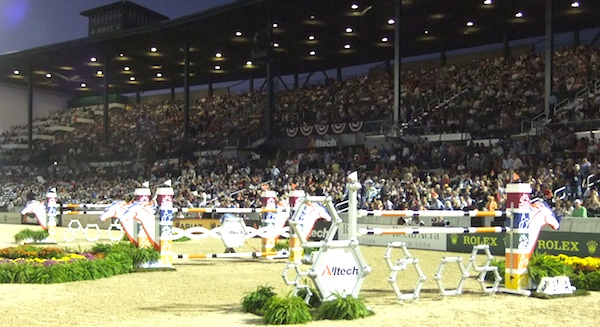
The World’s Highest Jumping Athletes
Show Jumping challenges the horse and rider’s stamina, speed, agility, scope and precision. Over the course of several competitions Monday through Saturday (with Thursday as a day off), the rider finishing with the least number of penalties earned the Gold. Beginning with the Speed Competition, more than 120 horses and riders representing 27 countries competed on courses designed with a variety of Kentucky themes from horse racing and breeding farms to products and culture. The Americans looked promising taking the top two spots after the first day of competition but it was the German’s who took home the overall Team Gold Medal after Wednesday evening’s top 10 Team Final competition. The 30 riders with the lowest scores returned for the Individual Round on Friday.
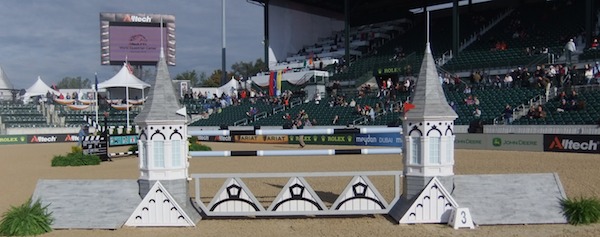
The exciting week of show jumping culminated with the top four riders, those with the lowest scores from the week, competing on Saturday evening for the Rolex Final Four. Making it to the Final Four from a talented pool of 121 riders is quite an accomplishment and an exhibition of a great partnership with a horse. This was the first year the Games had four riders from four different continents, Philippe Le Jeune of Belgium, Eric Lamaze of Canada, Rodrigo Pessoa of Brazil and Abdullah Al Sharbatly of Saudi Arabia. Each rider began their first round on course aboard their own mounts. Given the option to change only one piece of tack, and a maximum of three minutes to acclimate to the new partner, it was time for riders to display true horsemanship as they attempted the same course on each of the other rider’s mounts. Each horse and rider combination went clean in two of the four rounds. However the end result, and the only rider to jump clean all four rounds, was Belgium’s Philippe Le Jeune taking home the Gold Medal. And after five days of competition, the only horse to jump all four rounds of the Final Four clean was Lamaze’s mount Hickstead. The 14-year-old stallion was awarded Best Horse Honors for his amazing efforts.
For the first time
Amongst the multiple sessions of Show Jumping in the outdoor stadium, the Para Dressage, Vaulting and Driving disciplines also competed in outdoor and indoor facilities at the Kentucky Horse Park. The 2010 World Equestrian Games marked the first time riders with physical disabilities had the opportunity to contest their equestrian abilities while competing amongst the world’s best competitors. Participating riders were asked to complete tests involving specific movements typically seen in Dressage and also competed for individual and freestyle medals. Several countries were represented in the final results, but Great Britain and Germany were tops. British rider Sophie Wells on Pinnochio won Gold in the grade IV Individuals and the British Team were also Gold Medal winners. German rider Hannelore Brenner riding Women of the World took the Gold medal in the grade III.
Mounts and Dismounts Required
Performing gymnastics and elements of dance to music while balancing on horse cantering in a circle is certainly high-level gymnastics. In Compulsory, Freestyle and Team Competitions, vaulters are judged and scored on technique, form, difficulty, balance, security as well as consideration of the horse and the performance of designated exercises or movements. In addition, it is the only discipline holding separate competitions for males and females both in Compulsory and Freestyle Vaulting. The US Team of Devon Maitozo, Blake Dahlgren, Mary Garrett, Emily Hogye, Mari Inouye, Rosalind Ross, and Annalise VanVranken along with their horse Palantino lunged by Carolyn Bland won Gold in this event.
Driven
Horse and man partnership comes into play in the Combined Driving Event where each driver drives a team of four horses through three separate competitions. Driven Dressage requires the same test for all competitors and like ridden Dressage, is judged on the agility and movement of the horses. The 18-kilometer marathon challenges competitors across country, similar to Eventing’s Cross Country, tests the fitness, judgment, and horsemanship of the driver. The Obstacle-Cone competition is the final phase of competition where the Driver is required to drive his team through twist and bends without incurring faults. Lowest total score again determined the medals and the US Team of Chester Weber, Tucker Johnson, James Fairclough, and their fabulous teams of horse earned a Silver Medal, whereas American Tucker Johnson brought home an Individual Bronze. After driving competitively for a quarter of a century, Johnson is retiring from competition on a great note.
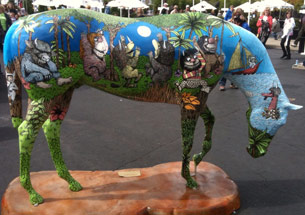

And there’s more…
Those who visited the Kentucky Horse Park on a general admission pass could easily fill the day with exhibits and events covering the park grounds. The trade shows offered high quality equestrian goods from apparel to tack and everything else horse, from artists to vacations.
The Equine Village provided guests the opportunity to meet breed and discipline registries as well as clinicians and other horsemanship organizations. There were daily demonstrations and clinics where several top competitors exhibited their talents and skills to spectators. The Kentucky Experience gave visitors from across the globe and even local guests the chance to see what Kentucky offers, from music, food, art, and recreation to of course the horse. The title sponsor, Alltech, created the Alltech Experience, a sprawling set-up with innovative rooms illustrating all the ways the company approached nutrition, health and performance. And that was just in the front, out back was a beer garden, areas devoted to kids, with animals of all kinds visiting from the Newport Aquarium, painted horses galore, music and more. Plus the permanent structures and exhibits at the park include several museums, a stable of breeds and several association headquarters.
Every aspect of the Kentucky Horse Park, especially hosting the magnanimous WEG is geared toward one purpose: to bring the world the majesty of the horse. Attracting the equestrian world to Lexington was a feat, and not without challenges, but certainly memorable for many. The World Equestrian Games showcased the athletes, both human and horse. The largest sporting event to come to the United States since the 2002 Winter Olympics, the 2010 WEG tallied a total of 507,022 in attendance by the final day. Hats off to the state of Kentucky who hosted an all-encompassing event that truly put the horse on a pedestal.
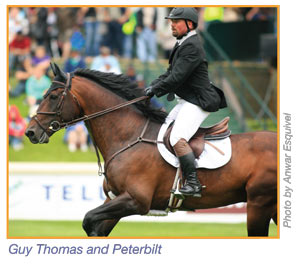 Northern California rider Guy Thomas is here. He has earned the honor of competing on a team, representing New Zealand. He will also be riding a homebred horse, Peterbilt, who he has developed from inception, along with his parents Butch and Lu Thomas. We had a chance to sit down with the man from Northern California with New Zealand roots and I have to say, he’s quite a guy.
Northern California rider Guy Thomas is here. He has earned the honor of competing on a team, representing New Zealand. He will also be riding a homebred horse, Peterbilt, who he has developed from inception, along with his parents Butch and Lu Thomas. We had a chance to sit down with the man from Northern California with New Zealand roots and I have to say, he’s quite a guy.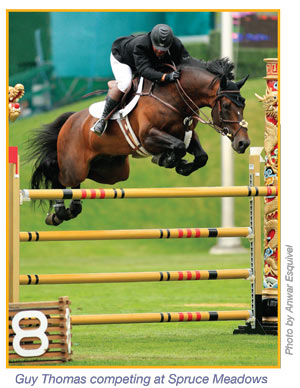 EqSol: Let’s talk WEG…
EqSol: Let’s talk WEG… Representing the West Coast, Duncan McFarlane piloted the eight-year-old Mr. Whoopy to an impressive eighth place finish, dropping just one rail on course, and Helen McNaught rode Caballo to the thirteenth position with an eight fault score.
Representing the West Coast, Duncan McFarlane piloted the eight-year-old Mr. Whoopy to an impressive eighth place finish, dropping just one rail on course, and Helen McNaught rode Caballo to the thirteenth position with an eight fault score. The WEG is here!
The WEG is here!